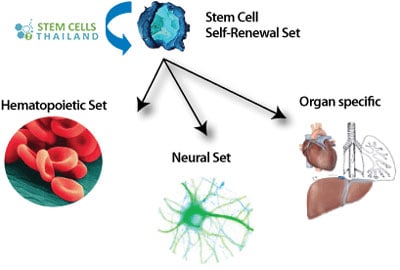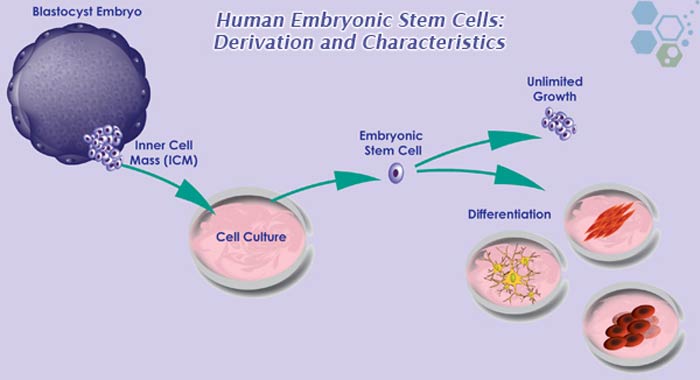Long-term self-renewal in regen medicine refers to the capability stem cells have for self-replication through continuous division. The result of this natural regeneration cycle is common amongst certain types of non-specialized cells. The process of self-renewing usually occurs over a long period (that could even run for years), and the length and rate of self-renewal is determined on the specific stem cell variant.[1]

The term “long-term self-renewal” often refers to the ability of stem cells to reproduce themselves for prolonged periods throughout the life of an organism. This capability allows stem cells to provide a continuous source of cells for growth, development, repair, and replacement of damaged or worn-out tissues. Let’s discuss the different stem cells and their long-term self-renewal properties:
- Embryonic Stem Cells (ESCs):
Origin: Derived from the inner cell mass of blastocysts (early-stage embryos).
Renewal: ESCs are pluripotent, meaning they can give rise to almost all types of cells in the body. They have a high capacity for self-renewal under appropriate culture conditions. - Adult (or Somatic) Stem Cells:
Origin: Found in specific tissues throughout the body, including the bone marrow, brain, liver, skin, etc.
Renewal: Their primary role is to maintain and repair the tissue in which they are found. Some adult stem cells have a limited differentiation potential compared to ESCs. Their self-renewal capacity can vary depending on the type of adult stem cell and the tissue environment. - Induced Pluripotent Stem Cells (iPSCs):
Origin: These are specialized cells (often skin or blood cells) that have been reprogrammed to revert to a pluripotent state, similar to ESCs.
Renewal: Like ESCs, iPSCs have a high capacity for self-renewal and can potentially differentiate into almost any cell type in the body. - Cancer Stem Cells:
Origin: A subpopulation of cells within tumors that have the ability to self-renew and to give rise to the heterogeneous lineages of cancer cells that comprise the tumor.
Renewal: They can self-renew and are believed to be responsible for tumor initiation, growth, recurrence, and drug resistance.
The self-renewal capability of stem cells is tightly regulated by intrinsic and extrinsic factors:
- Intrinsic Factors: These are cell-intrinsic genetic and epigenetic factors. For example, certain transcription factors, such as Oct4, Sox2, and Nanog, play crucial roles in maintaining pluripotency in embryonic stem cells.
- Extrinsic Factors: These include molecules present in the stem cell niche or micro environment that support and regulate stem cell behavior. This can include cell-cell interactions, cell-matrix interactions, growth factors, and cytokines.
Video about Long-Term and Continuous Self-Renewal
Clinical Significance of Long-Term Self-Renewal:
The understanding of stem cell self-renewal is essential in many clinical contexts. In Regenerative Medicine: By harnessing the self-renewal and differentiation properties of stem cells, The Regeneration Center is revolutionizing treatments for diseases like Parkinson’s, spinal cord injuries, liver cirrhosis, COPD, Diabetes and heart diseases.
Certain cancers contain cancer stem cells that contribute to drug resistance and recurrence. Understanding how to target these cells without harming normal stem cells will lead to better cancer treatments. Overall, the study of long-term self-renewal in stem cells provides insights into fundamental biological processes and holds promise for a variety of therapeutic applications.
The introduction of self-renewing hepatoblast like cells or “HBCs” from human multipotent and pluripotent stem cells “PSCs” that has helped us provide a high quality and stable supply of mesenchymal hepatocyte-like cells for regenerative medical applications.[2]
Published Clinical Citations
[1] ^ Deng, Y, X Zhang, X Zhao, Q Li, Z Ye, Z Li, Y Liu, et al. 2013. Long-term self-renewal of human pluripotent stem cells on peptide-decorated poly(OEGMA-co-HEMA) brushes under fully defined conditions. Acta biomaterialia, no. 11 (July 24). doi:10.1016/j.actbio.2013.07.017. https://www.ncbi.nlm.nih.gov/pubmed/23891809
[2] ^ Frelin, Catherine, Robert Herrington, Salima Janmohamed, Mary Barbara, Gary Tran, Christopher J Paige, Patricia Benveniste, et al. 2013. GATA-3 regulates the self-renewal of long-term hematopoietic stem cells. Nature immunology, no. 10 (August 25). doi:10.1038/ni.2692. https://www.ncbi.nlm.nih.gov/pubmed/23974957

